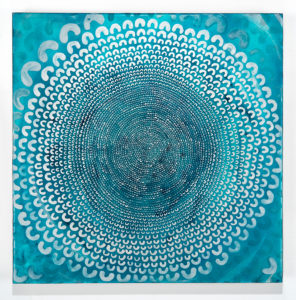Meditation and the Studio: Becoming Aware
It may surprise you to learn that I wasn’t a star pupil in art school. Not one of those students who carried those black, hard-backed sketchbooks everywhere, bursting with sketches, paintings and collages. Not the kind of art student who spent every waking hour making things. I was a diligent, attentive student. I did the assigned work, attended every class and loved it all. But when I started, I hadn’t the first clue how to turn out original work.

After graduation, I went through a difficult period in my creative life. I knew I wanted to devote my life to making art. But crushing self-doubts and critical voices plagued me every time I tried to work in the studio. I showed up to the studio regularly and managed to get work done, but I suffered from inexplicable fatigue due to the inner emotional stress of these critical voices. I sometimes grew distracted and unfocused. I sought out self-help books and groups for creative people, and slowly and subtly things began to change.
In my work as a teacher and artist for over thirty years, I know of many artists can relate to this feeling of paralysis or being stuck. For me, turning to mindfulness and meditation helped me make that shift to becoming the artist I am today. A lot of people believe that meditation or mindfulness is about reaching some exalted state, but it is actually about learning to be present.
When we practice meditation we naturally become more aware. Aware of our thoughts, our unconscious habits, the feelings and thoughts of the people around us, our impact on others. And the longer we practice, the more we notice. We notice subtle things that were always there – we just couldn’t see them before. Sort of like someone whose fuzzy vision becomes clearer with a new pair of glasses.

This type of deep noticing can have a profound impact on our creative work. As Paul Valéry put it: “To see is to forget the name of what one is seeing.” By being fully present with what we are creating, we can move beyond preconceptions and habits and encounter the work afresh.
If you’ve never spent time meditating before, you may find your mind to be a very messy place. Most of us have habits and patterns of thought that we unwittingly developed in our youth by simply imitating the patterns of thought of those around us. Patterned thoughts become like grooves in our brain – neural pathways – that can create habits of self-criticism, fear, doubt, cynicism, pessimism or worry. We scarcely notice them because they are so ingrained in us. And if we don’t notice them, we can hardly be aware that it is those habits or patterns of thought that are driving the circumstances around us.
If you are new to meditation, here are a few simple steps to experiment with it:
- Set aside 5 minutes each morning. As early as possible upon arising is easiest because your mind is still fresh and you don’t have as much resistance to the idea. (I’m too busy, I don’t feel like it, it’s too hard.)
- Find a comfortable and pleasant place to sit. One where you can sit in the exact spot every day.
- And if you have a smartphone, I suggest setting a timer with a gentle ring so your mind doesn’t need to be preoccupied with how long five minutes exactly is.
- Settle in: Ensure that your posture us upright, your chin ever so slightly turned down to elongate the back of your neck. Allow your shoulders to be comfortably loose and relaxed, with your shoulder blades on the same plan as your spine, rather than hunched forward.
- Gently close your eyes and just notice that breath. Pay attention as it fills your lungs quite easily and naturally, and then as it is expelled just as easily through your nostrils.
Thoughts will arise. About whether you remembered to take out the garbage last night, or the first appointment of the day, or that annoying thing your co-worker said yesterday. But you are not going to engage with those thoughts just now. You are going to notice the warmth of the breath as it gently flows in and out. And how your jaw has naturally unclenched and how every muscle is gently melting, releasing habitual tension. And the thoughts may come back: How long has it been now? Surely five minutes is up. I can’t sit here doing nothing! I have so much to do today! And then like a little child who has wandered off, you will gently take your mind by the hand and lead it back to the present moment.
If it helps, you can count your breaths. But just stay with the breath. And without noticing it, you have actually drifted into deep connection. You are not thinking. Then you notice that you are not thinking, and now you are thinking again. And so, you go back to your breath. Such is the task of a meditator. Like trying to take a knot out of a tiny thread with a needle. But hang with it. Please. It gets easier. Because you will untangle that knot and then that tiny thread will stretch out before you free of its knots. Before you know it, there is no thread at all.
Do you currently practice meditation in your daily life? Share your experiences in the comments below!
Leave a Comment
